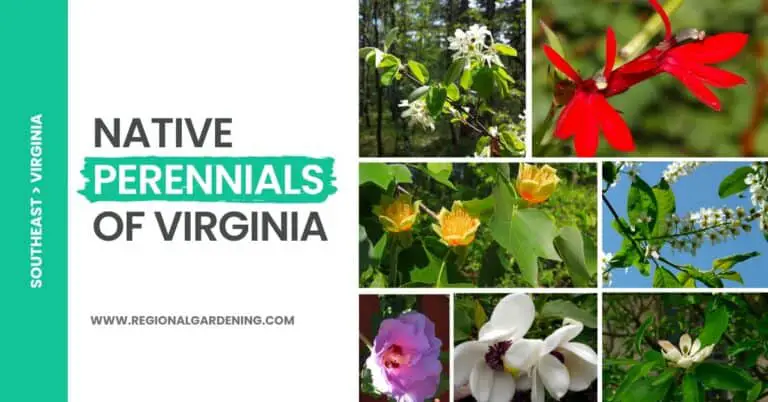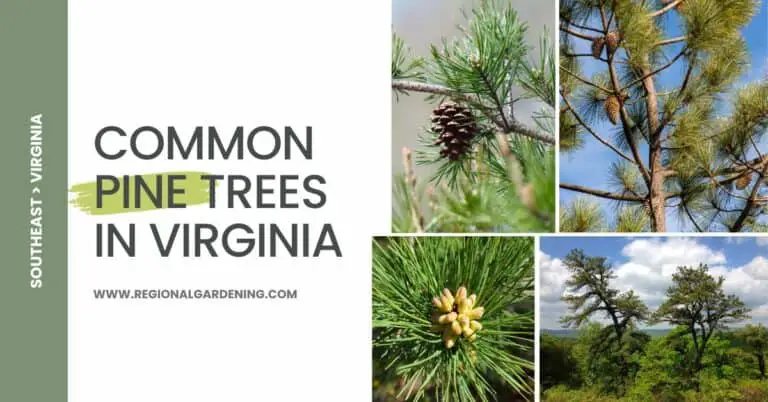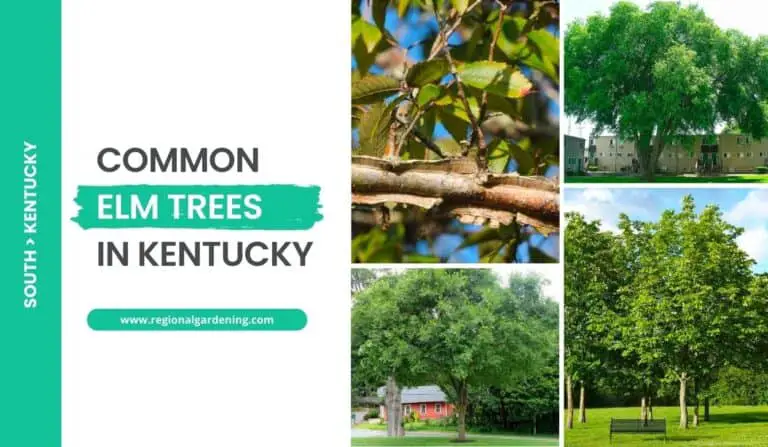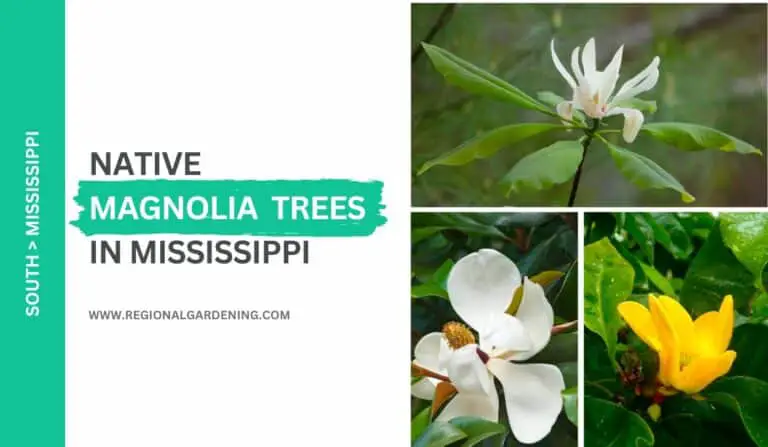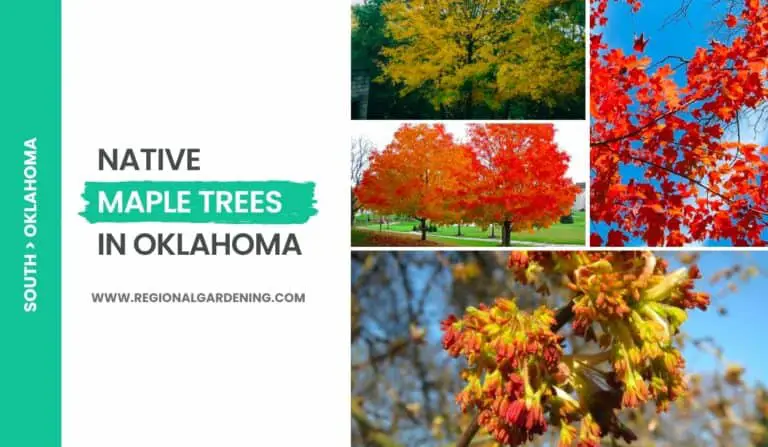8 Native Purple Trees In Mississippi (Purple Flowers & Leaves)
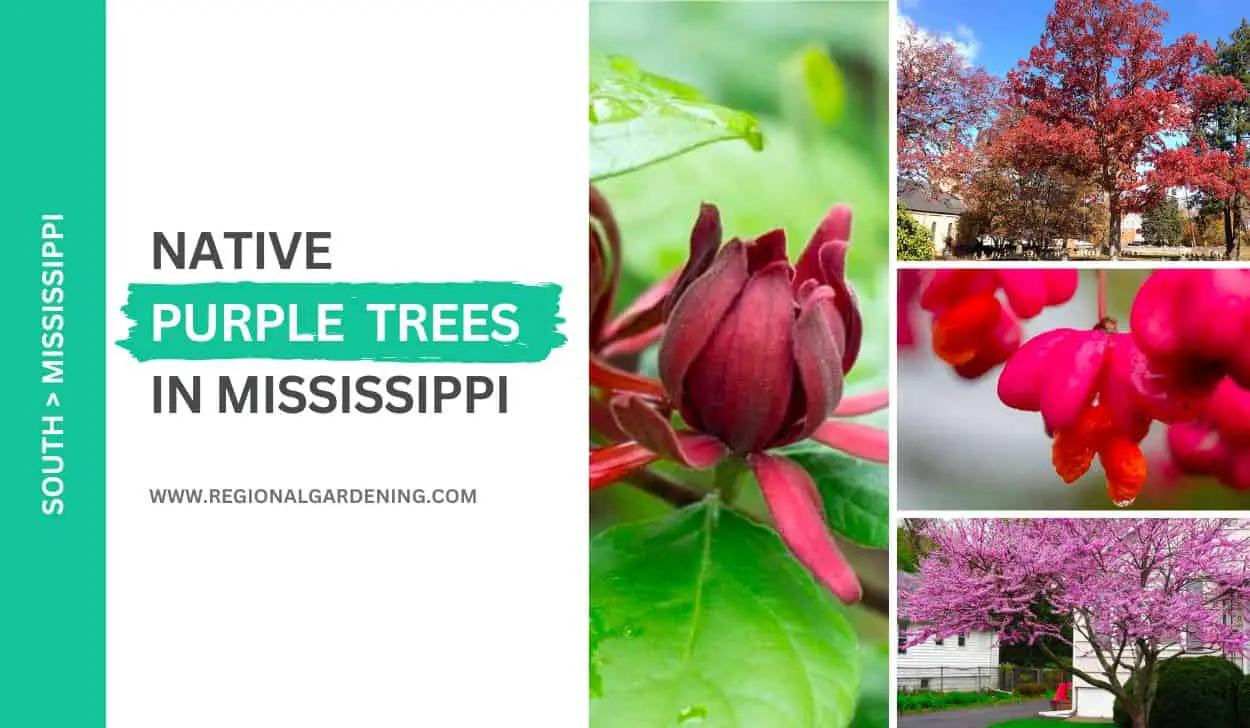
Mississippi is truly blessed with a diverse array of trees showcasing a delightful spectrum of colors. Get ready to fall in love all over again if the entrancing purple blooms of the Eastern Redbud captured your attention in other states.
In this article, we will delve into the enchanting world of commonly found native purple trees in Mississippi, boasting varying shades of purple in their flowers, leaves, cones, or bark.
Let’s start this colorful journey!
1. White Oak
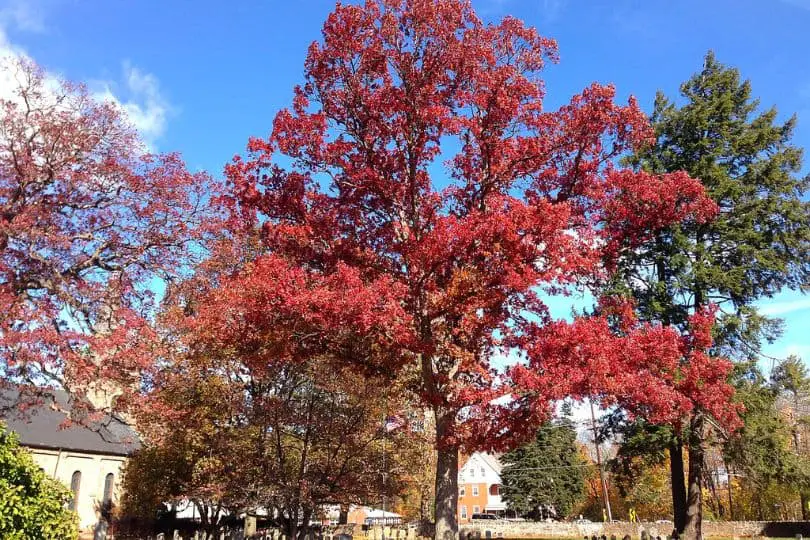
- Common Name: White Oak
- Scientific Name: Quercus alba L.
- Mature Height: 60.0’ – 100.0’
- Native Range: Throughout the US
- Flowers/Cones/Fruit: Yellow catkins
- Uses: Wildlife food and timber.
- Purple Color: Autumn Leaves
White Oak is one of the tallest purple trees in Mississippi, and it can grow to reach 60 to 100 feet tall.
The White Oak’s leaves are simple and deciduous, which means they fall off in the winter. They have a brilliant green top and a pale green to yellowish bottom. Many creatures, including squirrels, birds, deer, and raccoons, eat the acorns produced by the tree.
The White Oak is also an essential lumber tree since its wood is robust and long-lasting. It is used to manufacture furniture, flooring, and even wine and whiskey barrels. The White Oak is a lovely tree with a large circular crown and leaves that turn reddish-red to violet-purple in the autumn.
However, it is difficult to transplant and is sensitive to root zone disturbances, which might cause it to perish. Native Americans employed White Oak tree components for medicinal purposes as well.
2. American Hazelnut
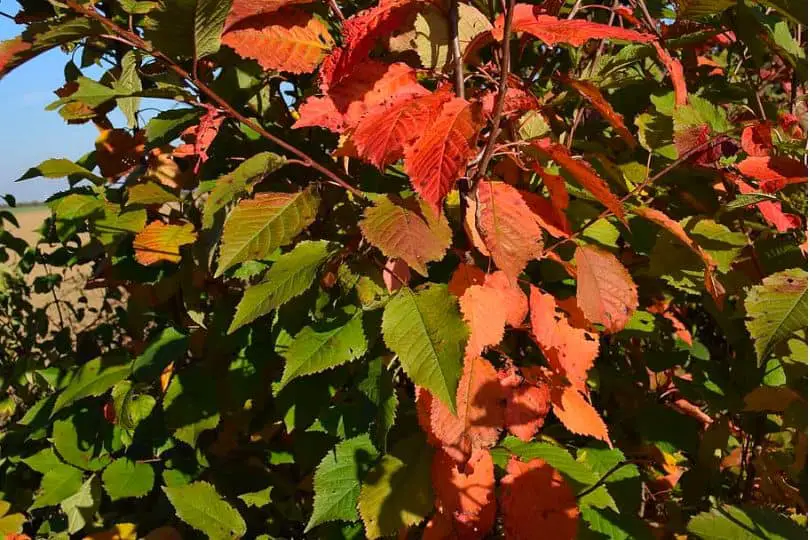
- Scientific Name: Corylus americana Walter
- Common Name(s): American Hazelnut, American Filbert
- Mature Height: 10.0′
- Native Range: Eastern half of the U.S.
- Fruits/Flowers: Nut: Monoecious, staminate catkins
- Uses: Wildlife food and ornamental
- Purple Color: Fall Leaves
The American Hazelnut (Corylus americana Walter), sometimes known as the American Filbert, is a deciduous shrub that can reach a height of 10.0 feet. It is indigenous to the eastern half of the United States, from Maine to North Dakota and south to Oklahoma, Arkansas, and Louisiana.
The American Hazelnut is appreciated in landscaping for its ornamental appeal and is frequently planted in naturalized situations. Because of its colonial tendencies, it is especially suitable for boundaries.
This small tree’s fall color is vivid scarlet or purple, adding to its aesthetic value. The plant is widely available from commercial producers, although there are no varieties other than the wild species.
The plant produces delicious nuts that are enclosed in two enormous downy, serrated bracts, as well as small white flowers. The nuts are extremely nutritious and are eaten by a variety of wildlife species such as squirrels, foxes, turkeys, woodpeckers, and deer. Rabbits, deer, and moose also consume the leaves, twigs, and catkins. Many wildlife species benefit from the
American Hazelnut’s dense, low-growth habit, provides cover and nesting locations.
While the American Hazelnut has little wood value, it plays an important ecological role in its native area. It prefers wet, chilly highland locations and grows best in fine to medium-textured soils with pH levels ranging from 5.0 to 7.0.
It grows slowly and has a relatively short life span of less than 50 years. The American Hazelnut tolerates shade, drought, and fire reasonably well, but not anaerobic conditions.
3. Eastern Redbud
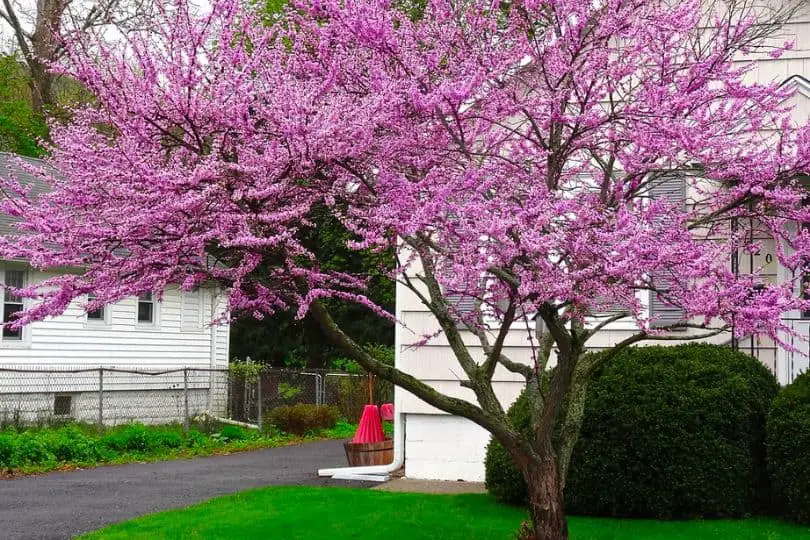
- Scientific Name: Cercis canadensis L.
- Common Name(s): Eastern Redbud, Judas tree
- Mature Height: 16.0′
- Native Range: New Jersey to Florida, west to eastern Texas
- Fruits/Flowers: Purplish pink flowers in clusters of 4 to 8
- Uses: Highly ornamental, wildlife food, medicinal purposes.
- Purple Color: Flowers
The Eastern Redbud trees are one of the most prevalent purple trees in Mississippi. It is often known as Judastree and has simple, alternating leaves. The kidney-shaped leaves are bright green on top and lighter on the bottom, with a heart-shaped to flattened base. With a moderate growth rate, the tree can reach a height of 16.0′. It is native from New Jersey to Florida, and west to eastern Texas.
The Eastern Redbud produces lateral clusters of legumes and purple-pink flowers in clusters of 4 to 8. Birds, notably bobwhite quail, eat the seeds, and the tree provides food for white-tailed deer and other mammals.
It is popular as an ornamental tree due to its colorful flowers and heart-shaped leaves. Because it is drought-resistant and can grow in soils of moderate to low fertility, the Eastern Redbud is widely utilized in landscaping.
The Eastern Redbud has cultural significance for Native American tribes such as the Alabama, Cherokee, Delaware, Kiowa, and Oklahoma tribes, in addition to its usage in wildlife habitats and gardening. Blossoming branches were introduced into homes to “drive winter out.” The tree’s bark can be used to make a tea that is traditionally used to cure whooping cough.
4. Burning Bush
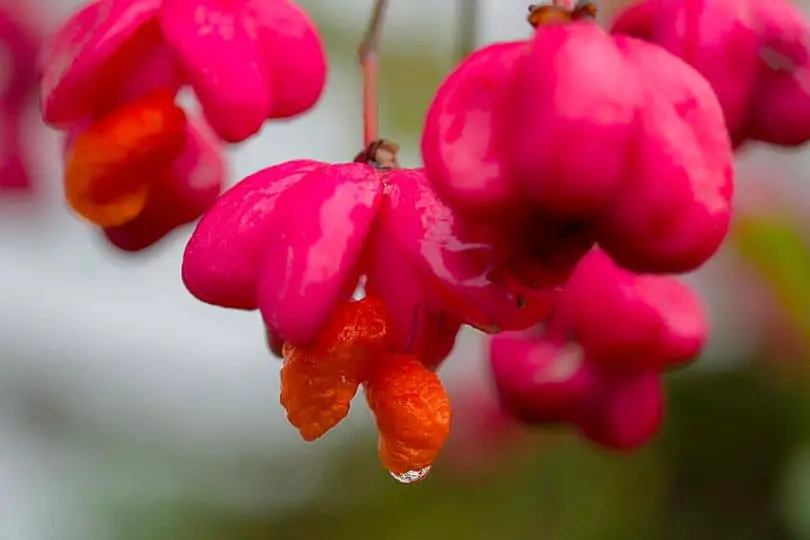
- Scientific Name: Euonymus atropurpureus Jacq.
- Common Name(s): Burning bush eastern wahoo, spindle tree
- Mature Height: 12.0’ – 25.0’
- Native Range: Widespread in the eastern U.S.
- Fruits/Flowers: Dark purple flowers
- Uses: Leaves and twigs are favorite browse for white-tailed deer; seeds are eaten by birds.
- Purple Color: Flowers
Burning bush, eastern wahoo, or spindle tree is a deciduous tree that can grow to be as tall as 25.0 feet. This tree’s leaves are simple, opposite, and delicately or doubly serrate, with a bright green color above and a softer color below. Twigs are thin and purplish green, with noticeable pale lenticels, half-round/half-oval leaf scars, and 0.25″ long terminal buds.
This tree’s fruit is a deeply lobed capsule containing seeds encircled by a thin fleshy, crimson aril. The flowers are dark purple and occur in axillary cymes with 7 to 15 flowers.
This tree is endemic to damp, fertile soils in forests and thickets. It grows slowly, reaching a maximum height of 25.0′ after around 20 years. The tree has a life expectancy of less than 50 years.
It tolerates shade and is moderately resistant to drought, fire, and anaerobic environments. This tree can be propagated from seed (cold stratification necessary), bare root, container, or cuttings.
Burning bush is prevalent in the eastern United States in terms of habitat distribution. According to Nature Serve county distribution records, it is classified as “imperiled” in Mississippi.
This tree is beneficial to animals because white-tailed deer frequently eat on its leaves and twigs, and birds dine on its seeds. This tree has minimal wood value and is rarely utilized in landscaping due to its sensitivity to scale and disorderly growth habit. When grown in open locations, it is flexible and easy to transplant, with appealing fruit and good fall color.
5. Pawpaw
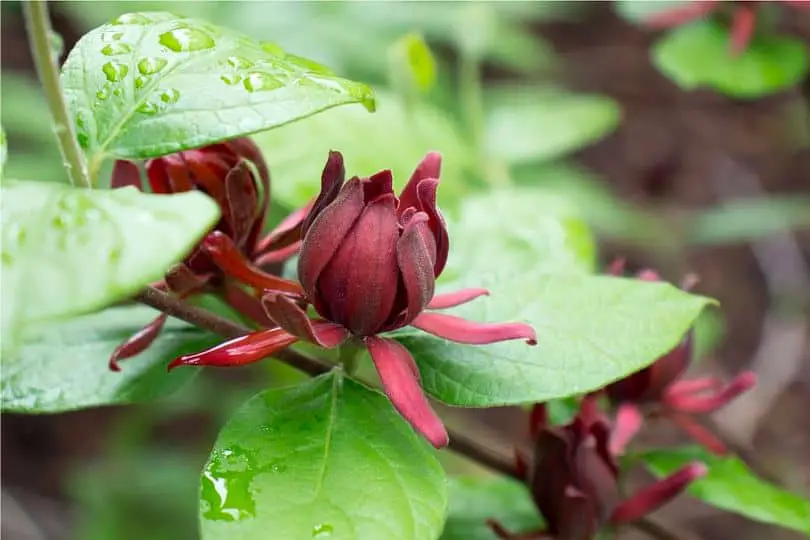
- Scientific Name: Asimina triloba (L.) Dunal
- Common Name(s): Pawpaw false banana, custard apple
- Mature Height: 35.0’
- Native Range: Throughout North America
- Fruits/Flowers: Purple, monoecious, perfect, and solitary flowers.
- Uses: Edible fruits.
- Purple Color: Flowers
The Pawpaw false banana, commonly known as Asimina triloba, is a deciduous tree with simple, alternating leaves.
The leaves are fragrant and smell like bell peppers. They are ovate-oblong in shape, 10.0″ – 12.0″ long and 4.0″ – 6.0″ wide, and light green above with a paler tint below. The twigs are slender and light brown, and the buds are bare, with oblong leaves and globose flower morphologies.
The berries are spherical or pointy, with thin skin and a golden custard-like pulp. The berries are 3.0″ – 5.0″ long and oblong to cylindrical, beginning green with dark gray markings in summer and maturing to dark brown to black. The flowers are purple, 2.0″ in diameter, and have six petals, the inner ones half the length of the outer ones.
The Pawpaw false banana is a single or multiple-stemmed tree that can reach a mature height of 35.0′. It grows slowly, reaching a maximum height of 30.0′ after 20 years. The tree has a life expectancy of less than 50 years.
It is shade-tolerant and prefers medium to coarse soil texture, with a pH range of 5.2 to 7.2. The tree grows best in deep, rich, moist soils found along streams and in the bottomlands. In some regions, particularly the lower Mississippi River Valley, it creates dense thickets.
Several wildlife species, including opossums, raccoons, foxes, and squirrels, eat the fruit of the Pawpaw false banana. The larvae of the zebra swallowtail butterfly feed on the leaves of the tree. The tree, however, has no major wood value.
The Pawpaw faux banana is an edible landscape plant that offers a tropical flavor to temperate environments. It can be grown as a screen or as a specimen tree in a container.
When grown in the sun, the tree has a conical pyramid-like shape, however, when grown in the shadow, the structure is more open. While the fruit thrives in the sun, it requires a shade structure during the first few years to provide filtered sunlight.
6. White Ash
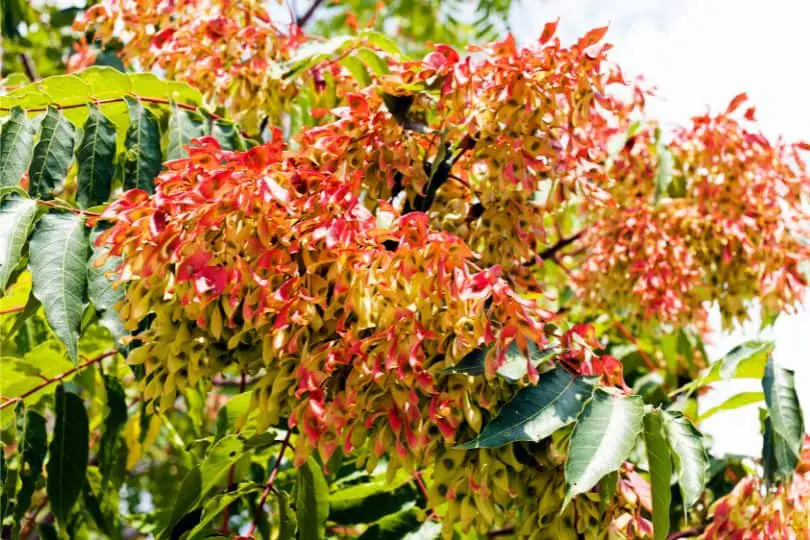
- Common Name: White Ash or Biltmore Ash
- Scientific Name: Fraxinus americana L.
- Mature Height: Up to 90.0 feet
- Native/Non-Native: Native
- Uses: Wildlife food, fuelwood, lumber, and other products such as handles, oars, and baseball bats.
- Purple Color: Purple Anthers in Flowers.
White Ash, also known as Biltmore Ash or Cane Ash, is a deciduous tree with big, odd-pinnately complex leaves.
The leaves are green on top and paler green on the underside. They have toothed edges and appear in groups of 5-9 long and wide leaflets. The tree has medium-sized, green to gray-brown twigs with big light lenticels and narrow concave leaf scars. Its buds are big and spherical, with dark brown to brownish-black scales.
The tree produces little green blooms that are dioecious, which means that male and female flowers exist separately. Male blooms are green with purplish anthers, whereas female flowers have two dark purple stigmatic lobes that spread.
The White Ash fruit, known as samara, is rectangular to spatulate in shape and pale brown. These clustered fruits are roughly 1-2 inches long and 0.25 inches broad.
White Ash is a tall tree that can grow to be 90.0 feet tall. It can live for more than 50 years and has a moderate growth rate. The tree prefers rich, wet, well-drained soils in uplands and bottomlands near streams. It is native to North America, stretching from Nova Scotia to northern Florida, and from eastern Texas to eastern Minnesota.
The tree can be used for a variety of purposes. Wood ducks, bobwhites, purple finches, pine grosbeaks, and fox squirrels eat its seeds. White ash wood is highly prized and used for fuelwood, timber, and nursery stock. Its strength, toughness, and stress resistance make it ideal for handles, oars, baseball bats, cabinets, train wagons, and ties.
White Ash is utilized in landscaping in addition to its practical applications. Its tree form is aesthetically attractive and can be planted in yards or along streets. While its fall color is not very striking, the tree can handle a wide range of soil conditions. It is, nevertheless, vulnerable to air pollution, particularly ozone and sulfur dioxide.
Interestingly, the juice from White Ash leaves has been used topically to treat mosquito bite swelling and itching, and the leaves were once thought to provide rattlesnake protection if carried in one’s boots or pockets.
Even though it has only a small purple portion, it is considered among the purple trees in Mississippi due to its popularity in the state.
7. Carolina Ash
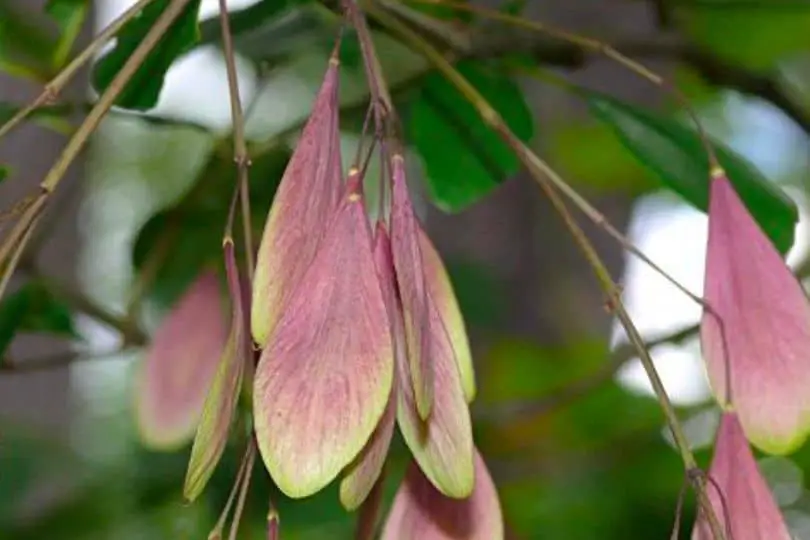
- Common Name: Carolina Ash
- Scientific Name: Fraxinus caroliniana P. Mill.
- Mature Height: Up to 39.0 feet
- Native Range: From Washington D.C. to Florida, along the Gulf Coastal Plain to Texas
- Flowers/Cones/Fruit: Small, apetalous flowers.
- Uses: Landscaping.
- Purple Color: Flowers
The Carolina Ash, also known as water ash, pop ash, or swamp ash, is a tree that can grow to be 39 feet tall. It’s most abundant in deep river marshes that are inundated for several months of the year.
The Carolina Ash has deciduous leaves that are dark green on the upper surface and paler green on the lower surface. Before the leaves appear, the tree produces tiny blooms.
Carolina Ash has slender twigs that are greenish gray when young and age to brown or gray. In addition, the tree features chestnut brown ovate-acute buds. Carolina Ash bark is dark and thin, with irregular scaly ridges.
The Carolina Ash is native to a large region, stretching from Washington, D.C. to Florida and west to Texas along the Gulf Coastal Plain. It is shade tolerant and has a good tolerance for anaerobic environments. Without the need for cold stratification, the tree can reproduce by seeds.
Carolina Ash has no economic timber value because of its light, weak, and mushy wood. However, due to its attractive characteristics and capacity to tolerate moist soils, it is frequently used in landscaping.
8. Green Ash
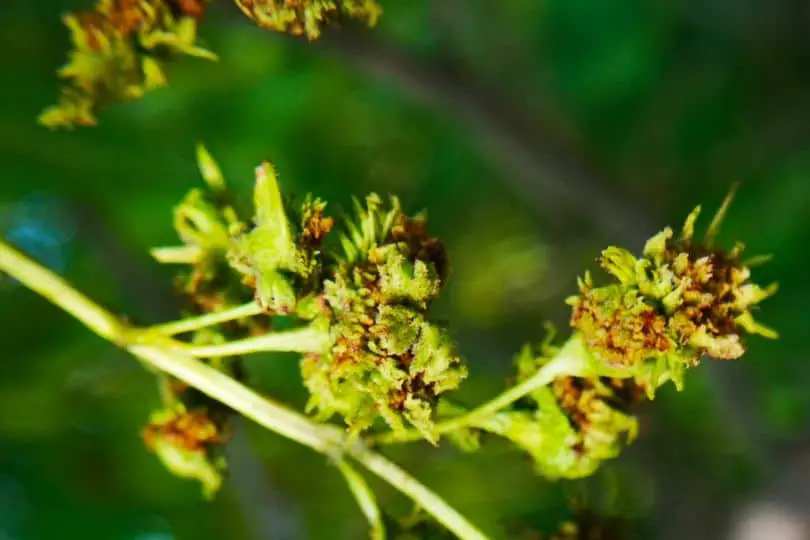
- Common Name: Green Ash
- Scientific Name: Fraxinus pennsylvanica Marsh.
- Mature Height: 70.0 feet
- Native Range: Central Montana and northeastern Wyoming to southeastern Texas, east to northwestern Florida, and north to Nova Scotia, Mississippi
- Flowers/Cones/Fruit: Small purplish red flowers.
- Uses: Tool handles, furniture, and interior furnishings.
- Purple Color: Flowers
Green Ash, sometimes known as red ash, swamp ash, or water ash, is a deciduous tree that can reach heights of 70 feet. Its leaves are pinnately complex, which means they have numerous leaflets and are dark green on top and paler green on the underside. The Green Ash produces huge clusters of winged seeds called samaras, which are paddle-shaped and encapsulate the seeds. It has little purple-red flowers as well.
The Green Ash’s bark is gray and tight, and its twigs are grayish green in hue. This tree can be found in wet and dry areas, as well as along streams and floodplains. It can endure shade, medium drought, and fire, but not anaerobic conditions.
Green Ash is beneficial to nature since its seeds are consumed by numerous animals and birds. Birds, bunnies, deer, squirrels, and sharptail grouse flock to it. However, it has a limited protein potential.
The Green Ash is a common shade tree in home landscaping. It has a good shape and may be used in a variety of settings. It is also relatively bug and disease free.
Similar Articles
- Native Flowering Trees In Mississippi
- Common Fruit Trees In Mississippi
- Native Pine Trees In Mississippi
- Common Palm Trees In Mississippi
- Native Oak Trees In Mississippi
- Common Birch Trees In Mississippi
- Native Elm Trees In Mississippi
- Native Magnolia Trees In Mississippi
- Native White Flowering Trees In Mississippi
- Common Pink Flowering Trees In Mississippi
- Native Plum & Cherry Trees In Mississippi
- Native Ash Trees In Mississippi
- Native Maple Trees In Mississippi
- Native Cypress Trees In Mississippi
- Native Hickory Trees In Mississippi
- Native Nut Trees In Mississippi
Purple Trees In Mississippi – Sources
The Regional Gardening team makes sure that the information in our articles is accurate by only using sources that are known to be trustworthy. Some of these sources are peer-reviewed journals from government agencies, well-known universities, and scientific research organizations.
- Native Trees For Mississippi Landscapes, Mississippi State University Extension.
- Mississippi Trees, Publications Of Mississippi Forestry Commission.
- Department Of Plant & Soil Sciences, Mississippi State University Extension.
- Tree Care, Mississippi Urban Forest Council.


